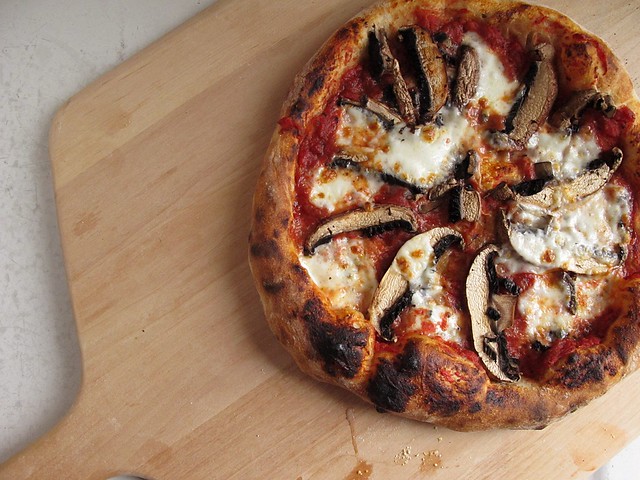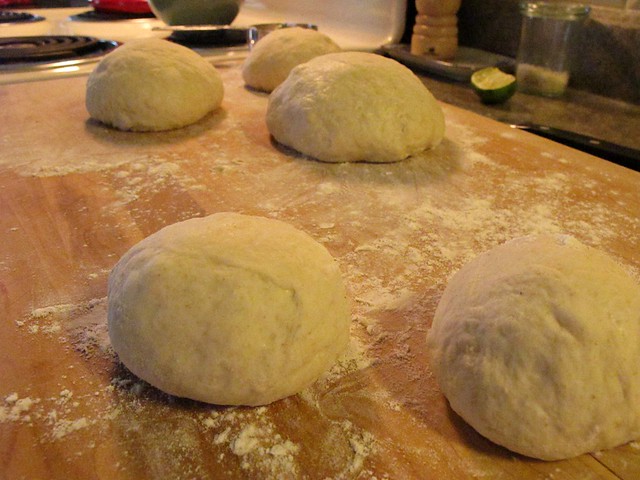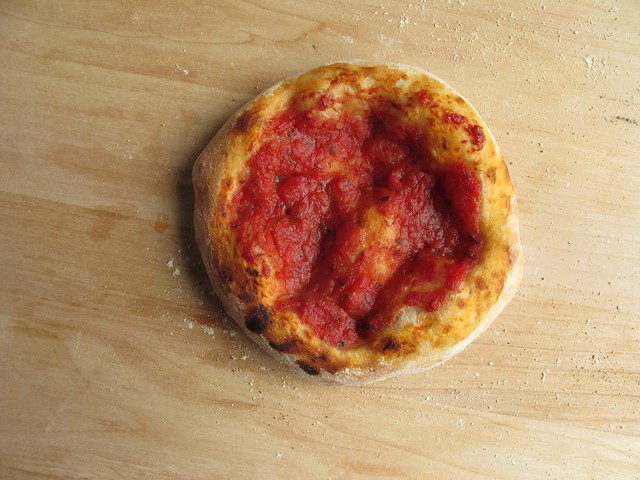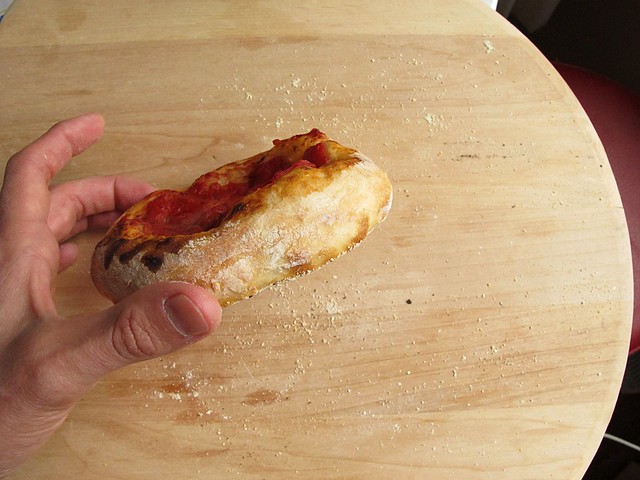I think at some point in his or her life, most people who enjoy baking naturally become obsessed with making the perfect pizza. Pizza, born of Italy and Greece, seems purely American to me, and every American I know has a pizza preference whether it be thin, thick, sparse or dense with ingredients. Pizza is one of the first things I ever made without help, and one of the things that grows with me as I change little by little in my kitchen life. This newest incarnation would satisfy just about any pizza eater regardless of pizza preference, and it comes from the guy who unknowingly started me on my path to real bread making.

A continual learning process had dropped me off on the corner of sparse toppings (as a general rule, I use no more than three ingredients) and medium weight, sourdough or sourdough-esque crusts. That is a very happy corner to wait around on! I snatched up Jim Lahey's new book, My Pizza, at my library recently and near instantly applied his maverick electric oven hack to a different pizza dough and was thoroughly impressed.
I'm even more impressed now that I've made his conventional yeast dough. The dough is a no-knead type, made quickly and then left with an 18-hour or so relax time. When it comes time to bake it, it bakes up fluffy, soft and with a thin brittle bottom crust. It has just the perfect amount of deep, near black scorchings, and a perfect blend of crispiness and chewiness. Baking a pizza by broiling it also puts a hot pie on the table in about 3 minutes, which is pretty amazing too. A quick bake time allows to eat them nearly on demand, immediately after they emerge - which is always when pizza tastes best - and then easy repetition to bake off another one in short order.
(Food52 has the new Lahey method pizza recipe back up on their website, the only tweaking I did was to use Kosher salt and a handful (50 g.) of high protein whole wheat flour in place of 50 g. of the white stuff. I detailed the electric oven hack in the caption of this flickr photo if you are curious... For the pizzas I made last night, I just used several 1/4 inch thick slices of portobello mushrooms, some fresh mozzarella, and some red sauce as a base layer.)
I'm even more impressed now that I've made his conventional yeast dough. The dough is a no-knead type, made quickly and then left with an 18-hour or so relax time. When it comes time to bake it, it bakes up fluffy, soft and with a thin brittle bottom crust. It has just the perfect amount of deep, near black scorchings, and a perfect blend of crispiness and chewiness. Baking a pizza by broiling it also puts a hot pie on the table in about 3 minutes, which is pretty amazing too. A quick bake time allows to eat them nearly on demand, immediately after they emerge - which is always when pizza tastes best - and then easy repetition to bake off another one in short order.
(Food52 has the new Lahey method pizza recipe back up on their website, the only tweaking I did was to use Kosher salt and a handful (50 g.) of high protein whole wheat flour in place of 50 g. of the white stuff. I detailed the electric oven hack in the caption of this flickr photo if you are curious... For the pizzas I made last night, I just used several 1/4 inch thick slices of portobello mushrooms, some fresh mozzarella, and some red sauce as a base layer.)

A full recipe of Lahey's new dough makes 4 pizzas, but I cut one of the quarters in half to please my Kiddo who only eats sauce pizza. I make my pizza sauce with drained quarts of homecanned tomatoes augmented with garlic, spices and maybe some tomato paste if it seems too thin. Baking the smaller pizzas under the broiler seemed to make them too dark too fast, so I experimented by baking it at a solid 500 degrees and omitting the broiler altogether. It worked well, but make a thicker crust all around - an even, airy crust that maybe would have been weighted down a little more if there were more toppings (any toppings) involved.

I stretched the other three portions into 12 inch or so rounds, the dough soft and stretchy, a remarkably easy dough to work with when floured and handled gently but firmly. I really think this pizza is going to hang around for most of the Summer, it was so easy and so good. Since my stand mixer has died a third time, I'm thinking that less work and less hand kneading may be on my agenda for awhile whether I like it or not, but recipes like this one are a solace to my machine angst, reminding me that I don't need machines to produce great food.

While there were many good pizza combinations in the good book, I was disappointed with petty things like the font, the book size and feel, and the hastiness of the author voice. I loved the first (My Bread) book so much - and I haven't forgotten that there is a Lahey Project tab at the top of my page here regarding it, I may just resume work on the recipes from that book soon - that this one couldn't compare. Though certainly I will soon be making vegan pizzas with pureed walnuts in lieu of sauce, and the simple pork sausage recipe I already made was a definite keeper... perhaps even worth the cover price alone for ease and taste.
The road to great pizza winds on, and this approach is definitely worth the time to experiment on. Whenever I get all excited about a new pizza, I forget that before it came a pretty great pizza, and that is what baking life is all about. I hope I never tire of finding new doughs, new techniques, new toppings to inspire me never to eat pizza outside my home ever again. As of this writing, I'm feeling pretty close.
This post has been Yeastspotted.
This post has been Yeastspotted.



























